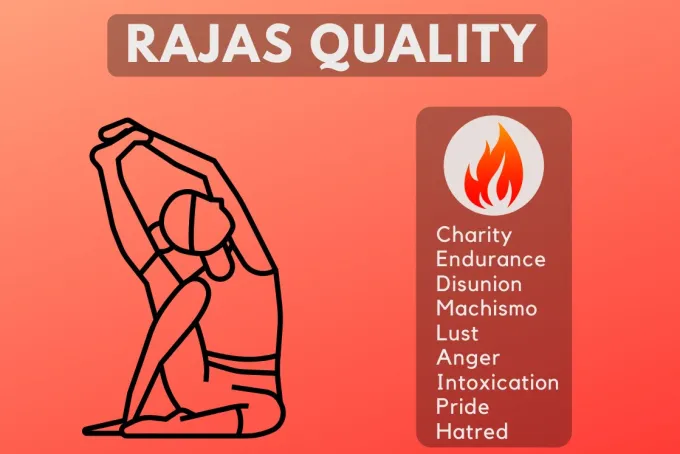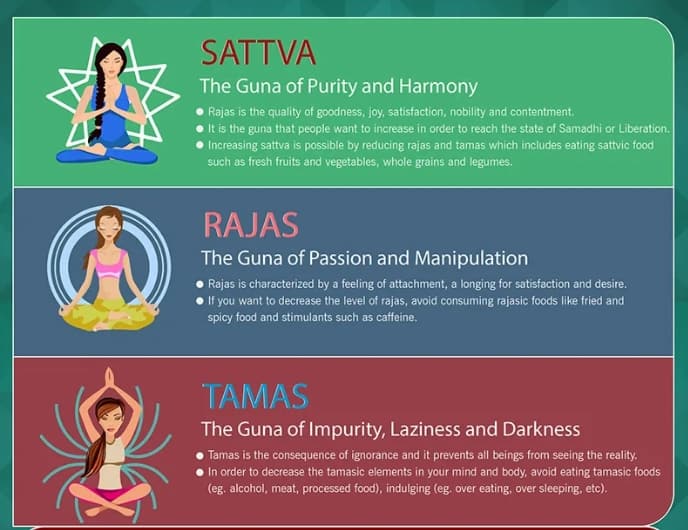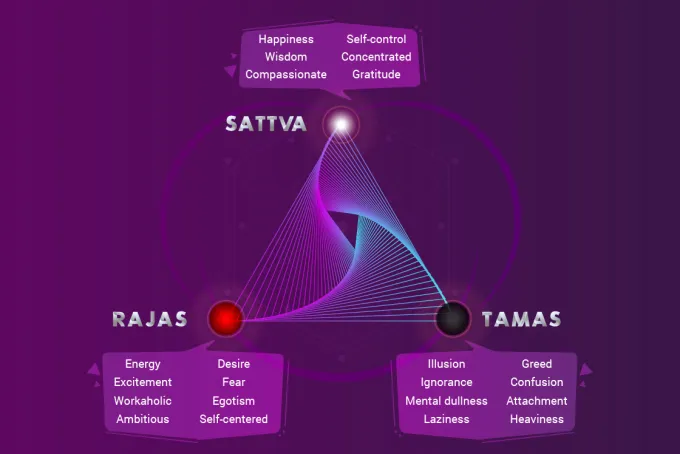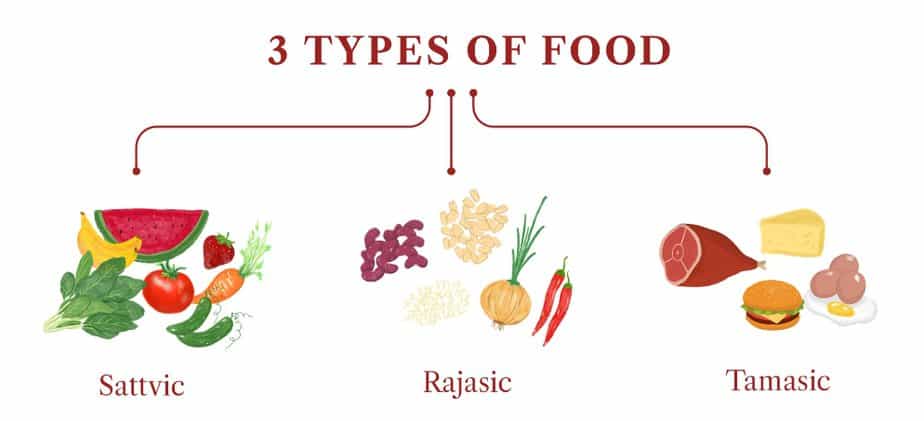Rajas Gunas is the attribute of a person or substance that promotes motion or action. Because of the large proportion of Rajas Gunas in Chitta’s formation, our mind is usually found in a wandering state. It is the reason meditation doesn’t come easily.
The three Ayurvedic Gunas are the fundamental life energies that pervade our bodies and the world around us. They reflect ever-changing energies, and while enhancing Sattva (representing harmony) is the ultimate goal, an excess of Rajas (representing motion) and Tamas (representing inertia) can be detrimental to our physical and mental well-being.
Understanding the Gunas and how they appear in the world is an important aspect of Ayurvedic and yogic practice, allowing one to respond to imbalances and diseases effectively and optimize positivity, harmony, and tranquillity in their life.
Among the 3 Gunas of nature, Rajas guna is the hyper state of Sattva and Tamas. Where Tamas is a state of inactivity, Rajas is the cause of activity, and finding a balance between these two is called Sattvic Guna.
Rajas are ruled by motion, energy, activity, and passion. When manifested in nature, Rajas drives the flowering of plants and the proliferation of life; it drives growth, change, and development. Given that it is characterized by energy and movement, Rajas tend to dominate during exercises like yoga.
When in balance, Rajas can motivate us to work hard in order to achieve our goals and ambitions. Whether we’re taking on new projects at work or building new relationships, Rajas empowers us to approach our experiences with energy, enthusiasm, and confidence
Rajas Gunas thus produces worry, overthinking, and hyperactivity when it is excessive. So, in order to achieve a sattvic condition, it becomes imperative to diminish or balance it.
However, it’s crucial to recognize your Rajas Guna before attempting to balance it.
Identify Your Rajas Guna

Each human has all three Gunas, which makes sense. You can look at your regular routine to identify Rajas Guna. Your behavior at a given moment reveals the prevailing Guna within you.
When Rajas Guna is in control, you exhibit the traits listed below:
1. Passionate and Impulsive
Rajas Guna individuals are passionate and appealing. They are constantly striving for more, which breeds greed and discontentment. As a result, their constant ambition to accomplish more causes them to become restless and hyperactive.
Due to their propensity for impulsivity, they frequently make rash decisions or behaviors that they later come to regret.
2. Defect Seeker (Forget Good Deeds)
A person with a dominating Rajas Gunas typically concentrates on the flaws in other people and things. They frequently overlook a person’s strengths while focusing on their flaws, errors, or negative actions.
They only consider a person’s flaws and fail to recognize their beneficial deeds. This action incited feelings of enmity and hostility. Furthermore, they are difficult to forgive.
3. Seeks for New
Rajasic persons are unable to remain content on their own. They require social interaction, friendship, and material possessions to feel fulfilled. However, they quickly become tired of their company and the things they are surrounded by.
Dominant Rajas Gunas causes a need for novelty, which drives people to seek out novel emotions and sensations. As a result, they are unable to develop a lasting relationship.
4. Selfish and Attention Seeker
Most Rajasic individuals are self-centered. They do not regard another person’s happiness as their own. These individuals just consider themselves. They frequently act self-centered and lack empathy for the pain of others.
Additionally, they take actions solely for fame and notoriety. For instance, if they assist someone, they do so out of fame or recognition rather than out of a genuine want to help. They frequently seek out attention.
5. Angry and Fearful
Rajas Gunas that abuses power makes a person angry and frightened. They have various fears, like fading from fame or falling behind others. They are constantly concerned that someone will pass them. As a result, they get irritated and irate easily.
Rajas Gunas in Yoga Practice

You can sense the presence of the three Gunas inside of you while performing any yoga asana.
Consider those positions where you find it difficult to get the desired outcome but are yet making increasing amounts of effort to delve deeper into the pose. Whether or not our body is moving toward the right side of the position and how much it aches doesn’t matter in this situation. It is a result of the mind’s Rajasic character.
Instead of this, you will be more likely to experience how naturally a position comes to you if you go into it deliberately while maintaining a balance between difficulty and safety. The sattvic state of the mind is what it is right now.
Types of Rajas Gunas
There are typically 16 different personality types based on the Gunas. Sattva Gunas come in seven varieties, Rajas Gunas in six, and Tamas Gunas in three.
Rajas Gunas is classified into six categories based on conduct.
1. Asura (Sharing Traits of Asura/villain)
People who are Asura Rajasic are courageous, violent, gossipy, and self-aggrandizing. They seem intimidating and have a rough, assertive mindset.
2. Raksasa (Sharing Traits of Raksasa)
People who are Raksasa Rajasic are constantly envious, violent, and angry. They enjoy eating meat and other non-vegetarian foods, sleeping a lot, and being lazy. They are also intolerable and constantly angry.
3. Paisaca (Sharing Traits of Pisaca (evil being)
These people have a gluttonous lifestyle and a penchant for women. They are filthy and timid. Additionally, they have an unusual diet as a habit.
4. Sarpa (Sharing Traits of Snake)
When agitated, Sarpa Rajasic individuals are brave; nevertheless, when calm, they are cowards. They react quickly and are overly laid back. These individuals are also uptight rather than gluttons.
5. Praita (Sharing Traits of Departed Spirit)
Such folks are incredibly avaricious, disruptive, and backstabbing. They have an insatiable appetite. These individuals lack discipline and are erratic.
6. Sakuna (Sharing Traits of Sakuni-Bird)
These folks have strong feelings for both food and passion. These folks lack discipline, are messy, and are tense.
How to Reduce Rajas Gunas

Although Rajas creates energy and activity, its dominance needs to be balanced to achieve the sattvic state. Here are some ways you can reduce the dominance of Rajas Guna:
1. Practicing Restorative or Counter Pose
The most soothing strategy to lessen the effects of dynamic poses is found in restorative positions. One could consider adding a few restorative positions when practicing yoga to minimize Rajas Gunas.
Also, don’t forget to practice a counterpose after doing a deep forward bend or a backbend. It neutralizes the excess effect of pose and helps us come to a balanced state. Holding poses for a more extended period also calms down the rajasic mode.
2. Cooling down by Pranayama
The excess energy of Rajas Guna can be greatly reduced by changing our breathing patterns and incorporating cold breathing practices like pranayama.
Sitali Pranayama and Sitkari Pranayama are two types of pranayama that you can practice while the Rajas Guna is dominant. Additionally, relaxing breathing techniques like alternate nostril breathing can be used throughout a yoga practice.
3. Improving Eating Habits
Our behavior has a lot to do with our eating habits. Rajasic foods are acrid, bitter, sour, or excessively salty. You become overheated and hyperactive as a result, which makes you anxious.
So stay away from spicy and fried foods. Opt instead for light, healthy meals. Rajas Guna’s power would eventually decline as a result of this.
To lessen Rajas Gunas’ dominance, include more vegetarian, raw, whole grain, and plant-based proteins in your meal.
4. Give Your Senses Soothing Vibes
Our conduct is significantly influenced by both visuals and auditory. Rajasic is any violent or aggressive sound or imagery. These exacerbate anxiousness, aggressiveness, and anxiety.
So don’t let these vibes feed into your senses. Instead, soothe your senses by listening to, watching, and reading pleasant content.
5. Sleep Adequately
Sleep has a profound impact on how we behave. We become agitated when we don’t get enough sleep, and we become drowsy when we get too much.
So, make sure you get enough rest. Your body and mind will be able to unwind thanks to this, and ultimately your rajasic property will diminish.
6. Spend Time with Yourself
“Residence in village or town is in the Rajas Guna.” – Srimad Bhagavatam 11.25.25
Living far from nature, according to Srimad Bhagavatam, is a trait of Rajas Guna. The features of this Guna are enhanced by a hectic lifestyle away from nature. Take a break and spend some time by yourself in nature as a result.
7. Think for Other’s Wellbeing
“Work done with the intention of delighting in the outcomes is in the Rajas Guna.” – The Srimad Bhagavatam, 11.25.23
Living far from nature, according to Srimad Bhagavatam, is a trait of Rajas Guna. The features of this Guna are enhanced by a hectic lifestyle away from nature. Take a break and spend some time by yourself in nature as a result.
You can learn through karma yoga how to do selfless work. It will increase the sense of satisfaction and joy inside you, which leads toward sattva.
What is Sattva?

Sattva appears as purity, knowledge, and harmony. It embodies goodness, joy, fulfillment, dignity, and contentment. It lacks fear, violence, fury, and malice. Sattva is unblemished and forgiving. People desire to increase their Sattva guna in order to achieve Samadhi or freedom.
Sattva can be increased through diminishing rajas and tamas in both the mind and the body. Eat sattvic foods such as fresh fruits and vegetables, whole grains, and legumes to achieve this. Sattvic foods are fresh and pure, growing above ground and receiving beneficial energy from the sun.
You increase the sattvic aspects in your mind and body by practicing yoga and living a nonviolent lifestyle, surrounding yourself with positive people, and engaging in activities that bring you and others joy.
Definition of the Guna Sattva by Example of a Sattvic Teacher and Student
- A sattvic instructor has reached the pinnacle of spirituality. All living beings are seen as one by the yogi, who does not believe in or preach hypocrisy. He puts into practice what they preach! A Sattvic instructor is unaffected by both praise and criticism.
- The first two sub-stages of the Seven Stages of Knowledge have been mastered by a Sattvic student. He understands the distinction between the genuine and the unreal (discrimination) and has developed dispassion towards the unreal.
How do Gunas Influence Us?
The three guns have a profound impact. They have an impact on our thoughts, actions, habits, and personalities. A person impacted by tamas, for example, will have negative attitudes, actions, and habits. Even if he does a nice deed, his motivations will be influenced by Tamas.
Can we Influence the Three Gunas Sattva, Rajas & Tamas?
We, as humans, have the ability to actively alter the levels of the Gunas in our bodies and minds. We can change the Gunas by changing the presence and influence of external things, lifestyles, and thoughts. Whichever guna is dominant will influence how we see our surroundings. It will have an impact on one’s behavior, attitude, activities, attachments, and so on.
A tamasic individual, for example, will regard everything as negative and destructive. A more sattvic individual, on the other hand, sees the universe as positive and finds joy and contentment in everything. However, the mind is highly unstable and can easily shift from one main guna to another.
The Gunas and Food

You’ve probably heard the adage, ‘You are what you eat.’ That is, the quality of what we consume, digest, and absorb has a direct effect on how we look. what we are feeling and thinking Did you realize that what we eat has an impact on our Gunas? The goal is to consume highly nutritious foods, moderate rajasic foods, and reduce tamasic foods.
Sattvic Foods
Fresh, whole, and nutritious foods such as:
- legumes
- wholegrains
- vegetables, fruits grown in the sun is considered a sattvic food.
Rajasic Foods
Foods that are stimulating in nature include:
- spicy foods
- chilies and peppers
- vegetables like onions
- stimulants such as caffeine
- pulses and dals
Tamasic Foods
These foods that reflect lethargy are tamasic:
- fast foods like hamburgers, fries
- refined foods like white bread
- frozen foods, leftovers
- red meat such as lamb and beef
- mouldy cheeses like blue cheese
Where can Gunas be Found?
Gunas can be found throughout Maya. They are visible throughout the day, seasons, food, thoughts, and behaviors. For example, sattva is present in the early morning, rajasic in the afternoon, and tamas in the evening. Pure sattva cannot exist in the absence of rajas and tamas. Pure rajas cannot exist without tamas and sattva, nor can pure tamas exist without sattva or rajas.
Sattva connects us to the attachment to bliss, rajas to the attachment to an activity, and tamas to the attachment to delusion. We are bound to Maya as long as we are influenced by any of the three Gunas. The first step toward Samadhi or Enlightenment is to develop sattva and diminish rajas and tamas.
The ultimate goal is to be free of the three Gunas and see the reality beyond Maya. A person who has transcended the three Gunas is unconcerned about the duality of life, such as pain and pleasure. He or she is unaffected by the Gunas because he or she understands that the Gunas are a part of Maya and not the universe’s sole reality, which is the Self.
How to Identify Your Main Guna?
Once you’ve determined your guna, the idea is to eliminate the lower guna while improving the higher one until you’re entirely sattvic. The first step is to locate an appropriate teacher. Then, by incorporating the Yamas and Niyamas into your life, you can eliminate tamas and rajas from your thoughts, behaviors, and habits.
Each of the three Gunas has distinct properties. Sattva consists of pure elements, rajas of activity and a desire for self-benefit, and tamas of darkness and destruction. These three Gunas can be found in both persons and things. It is beneficial to identify your basic attribute or element so that you can perfect yourself using yoga philosophy ideas.
Conclusive Words
Remember, as you minimize Rajas, don’t go far away to Tamas. As you see, the Rajas Guna is minimized, focus on balancing or increasing the Sattva Guna.
You must alter your daily schedule and eating habits in order to balance Rajas Guna. But despite how simple it may seem while reading, it is not.
Given that you will be breaking your habits, maintaining this entire process may prove challenging. But if you’re committed, it’s not that difficult to lessen this Guna’s excess.
Since results do not appear immediately, all that is required of you is perseverance and consistency. You will eventually see improvements in yourself.





















